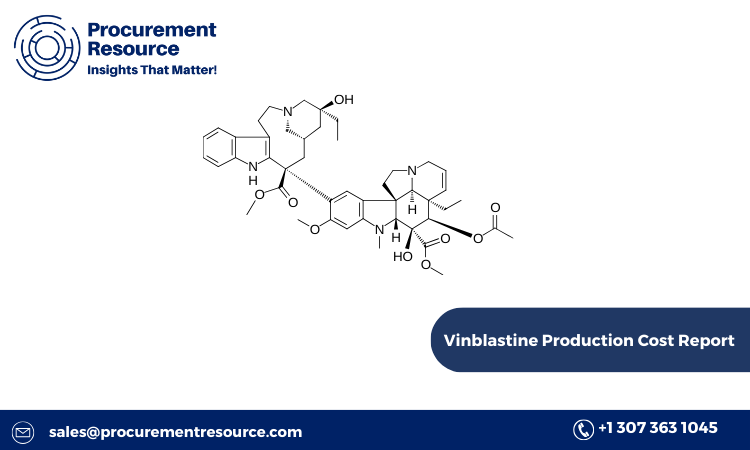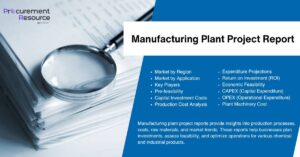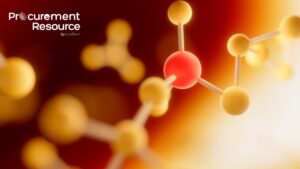
Vinblastine, an essential chemotherapy drug derived from the Madagascar periwinkle plant, is widely used in the treatment of various cancers, including Hodgkin’s lymphoma, non-Hodgkin’s lymphoma, and testicular cancer. The production of vinblastine is a complex process involving intricate extraction and synthesis techniques, making its production cost a critical factor in the pharmaceutical industry. Understanding the various elements contributing to the production cost of Vinblastine is essential for pharmaceutical companies, healthcare providers, and patients who rely on this life-saving drug.
Production Process
The production of Vinblastine involves multiple steps, beginning with the cultivation of the Madagascar periwinkle (Catharanthus roseus). The plant contains a group of alkaloids, among which Vinblastine and Vincristine are the most therapeutically valuable. The production process can be divided into the following key stages:
Request For Sample: https://www.procurementresource.com/production-cost-report-store/vinblastine/request-sample
- Cultivation and Harvesting: The first step in Vinblastine production is the cultivation of the Madagascar periwinkle plant. This plant is typically grown in tropical and subtropical regions where the climate is conducive to its growth. The plants are harvested at the optimal time to ensure the highest concentration of alkaloids.
- Extraction: Once harvested, the plant material undergoes an extraction process to isolate the alkaloids. This involves drying and grinding the plant material, followed by solvent extraction. The extracted solution contains a mixture of alkaloids, which is then subjected to further purification.
- Purification: The crude extract is purified using chromatography techniques to separate Vinblastine from other alkaloids and impurities. This is a crucial step to ensure the drug’s purity and effectiveness. The purification process is typically carried out using column chromatography, where the mixture is passed through a column containing an adsorbent material that selectively retains the desired compound.
- Synthesis: After purification, Vinblastine may undergo additional chemical modifications to enhance its therapeutic properties. This synthesis process involves specific chemical reactions to convert the natural alkaloid into a form suitable for medical use.
- Formulation: The final step in the production process is the formulation of Vinblastine into a dosage form suitable for administration. This typically involves combining the purified compound with excipients to create an injectable solution or other dosage forms. The formulation must meet stringent pharmaceutical standards to ensure safety and efficacy.
Manufacturing Report and Process
The manufacturing process of Vinblastine is both intricate and highly regulated. Given the drug’s therapeutic importance, maintaining consistency and quality throughout the production cycle is paramount. The process involves several critical steps, each contributing to the overall cost and ensuring the drug’s efficacy and safety.
- Quality Control: Throughout the manufacturing process, rigorous quality control measures are implemented to ensure the purity, potency, and safety of Vinblastine. This includes testing the raw materials, intermediates, and final product at various stages to detect any impurities or deviations from the standard.
- Batch Production: Vinblastine is typically produced in batches to maintain consistency. Each batch undergoes extensive testing to ensure that it meets the required specifications. The batch production method allows for better control over the process and ensures that any issues can be identified and rectified promptly.
- Compliance with Regulations: Vinblastine production is subject to stringent regulatory requirements, including Good Manufacturing Practices (GMP) guidelines. These regulations are enforced by agencies such as the U.S. Food and Drug Administration (FDA) and the European Medicines Agency (EMA) to ensure that the drug is safe for use.
- Scalability: Manufacturing Vinblastine at a commercial scale presents unique challenges due to the complexity of the extraction and purification processes. Scalability requires significant investment in specialized equipment and facilities, contributing to the overall production cost.
- Environmental Considerations: The production of Vinblastine also involves environmental considerations, particularly in the disposal of waste products generated during the extraction and purification processes. Manufacturers must adhere to environmental regulations to minimize the impact on the environment, which can also add to the production costs.
Raw Material Costs
The cost of raw materials plays a significant role in the overall production cost of Vinblastine. The primary raw material, the Madagascar periwinkle plant, is a key contributor to the cost. Several factors influence the cost of this raw material:
- Cultivation Costs: The cost of cultivating Madagascar periwinkle includes expenses related to land, labor, fertilizers, and pest control. The plant’s growth conditions, including climate and soil quality, also affect the yield and, consequently, the cost.
- Harvesting and Processing: The harvesting of the plant is labor-intensive and requires careful timing to ensure the maximum yield of alkaloids. Post-harvest processing, including drying and grinding, adds to the cost.
- Solvents and Reagents: The extraction and purification processes require various solvents and reagents, which contribute to the production cost. The quality and quantity of these chemicals directly impact the efficiency of the extraction and the purity of the final product.
- Chemical Synthesis Materials: If additional chemical synthesis is required, the cost of the reagents and catalysts used in the synthesis reactions must also be considered.
- Supply Chain Costs: The availability and cost of raw materials can fluctuate due to factors such as environmental changes, market demand, and geopolitical issues. These fluctuations can significantly impact the overall production cost of Vinblastine.
Latest News
Recent developments in the Vinblastine production landscape have focused on improving efficiency and reducing costs while maintaining the drug’s therapeutic efficacy. Key trends and news include:
- Advances in Extraction Technology: Research is ongoing to develop more efficient extraction techniques that can increase the yield of Vinblastine from the Madagascar periwinkle plant. Innovations such as supercritical fluid extraction and microwave-assisted extraction are being explored to reduce production costs and improve sustainability.
- Biotechnological Approaches: Biotechnological advancements are being investigated to produce Vinblastine through alternative methods, such as microbial fermentation or plant cell cultures. These approaches have the potential to reduce dependence on the Madagascar periwinkle plant and lower production costs.
- Regulatory Updates: The regulatory environment for Vinblastine production continues to evolve, with agencies emphasizing stricter compliance with Good Manufacturing Practices (GMP) and environmental standards. Manufacturers must stay informed about these changes to avoid potential disruptions in production.
- Market Dynamics: The demand for Vinblastine is influenced by trends in cancer treatment and healthcare access. As new cancer therapies emerge, the demand for traditional chemotherapy agents like Vinblastine may fluctuate, impacting production volumes and costs.
- Sustainability Initiatives: There is a growing focus on sustainability in pharmaceutical production, with manufacturers exploring eco-friendly practices and sourcing alternatives to reduce the environmental impact of Vinblastine production.
Conclusion
Understanding the production process and cost factors associated with Vinblastine is crucial for stakeholders in the pharmaceutical industry. As technology advances and regulatory landscapes evolve, the production of Vinblastine will continue to adapt, with the potential for more cost-effective and sustainable practices emerging in the future. Staying informed about the latest developments and trends in Vinblastine production is essential for ensuring the continued availability and affordability of this vital chemotherapy drug.

